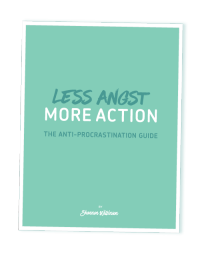It’s time to delve a little deeper into another one of the NLP Presuppositions.
This time it’s number 4
Every behavior is motivated by a positive intention. People make the best choices they can with the resources they have available.
This can be a lot to accept at face value. It usually fires off all kinds of buts and examples to the contrary.
How in the world could procrastinating on these things I have to do for my business have a positive intention?
There is absolutely no way my inability to get off the couch and get some exercise has a positive intention.
I can’t even begin to imagine a positive intention for eating a whole pan of brownies that makes me physically ill.
And that doesn’t even get into the actions that are crimes and harmful to others.
And yet, it is true.
You may not be aware of the intention consciously, in fact, I’d be willing to bet you aren’t. But if you explore deeply enough, you will find a nugget of positive intention. It’s that little nugget that makes it more desirable for you to do that thing you wished you didn’t do, rather than the thing you would like to do.
It goes something like this.
Let’s take that second example and I’ll show you what I mean.
Let’s say you would really like to start doing some exercise. Except that every evening, all you can think about is eating take out and zoning out to Entertainment Tonight. You know that exercise is good for you. That you’ll feel better if you do it. That hell, you might even have more energy if you did it.
But.
Listen to the buts and the fears that crop up. They can be the secrets to the positive intention.
Dig below the I don’t wannas, to find the specific buts:
But what if I get hurt (and can’t work, raise my family, grow my dream).
But what if look stupid (and people make fun of me).
But what if I feel worse (instead of better).
When you reach these specific buts, you can start to imagine the positive intentions behind them. For these it’s pretty much all about safety and security.
(Here’s a hint, if it’s hard to fathom why you’re doing something, look for where you’re trying to preserve your safety and security.)
When you make the positive intention conscious, and recognize what you’re really after (I want to feel safe) it becomes easier to satisfy that need and do what you really want to do.
(Bonus info: So in this case, what if exercise didn’t mean go to the gym/for a run/feel the burn/sweat buckets. What if it meant, a walk around the block, or one push-up, or doing a few bicep curls with your favorite hardback books during the commercials?)
Why does it matter.
When you start to look at actions through this filter, rather than a moral one, you can begin to see how every action is motivated by a positive intention. It can also help you separate actions from individuals.
How much easier is it to deal with someone who is driving you crazy, when you recognize that in their world, their behavior is motivated by a positive intention.
It makes it oh-so-much-easier to embrace the adage, it’s not about you.
Previously unexplainable behavior becomes understandable, although not necessarily acceptable.
That is a key distinction.
Just because something is motivated by a positive intention doesn’t make it okay. It still may be illegal, immoral or just plain ol’ unacceptable. But recognizing the intention, allows you to approach it in a different, more compassionate way, whether it’s your own behavior or the actions of someone else.
Learn more about NLP
Explore the other NLP Presuppositions:
- The map is not the territory.
- The meaning of your communication is the response you get.
- You have all the resources you need to achieve your desired outcomes.
- Every behavior is motivated by positive intention. People make the best choices they can with the resources they have available.
- You cannot not communicate. Effective communicators accept and utilize all communication presented to them.
- All outcomes are achievements, there is no failure, only feedback.
- The element in a system that has the most flexibility will be the catalyst of that system.
- Respect each person’s model of the world.


[…] Every behavior is motivated by positive intention. People make the best choices they can with the resources they have available. […]
[…] Every behavior is motivated by positive intention. People make the best choices they can with the resources they have available. […]